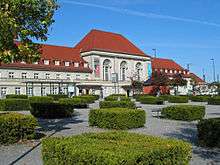Weimar station
Weimar station is the main station in the city of Weimar in the German state of Thuringia, located on the Thuringian Railway. It is an Intercity-Express stop on the line between Frankfurt am Main and Dresden. Weimar station is classified by Deutsche Bahn as a category 3 station. It is officially designated as a KulturBahnhof ("culture station”), as the station’s panels are noted. It is about one kilometre north of central Weimar at the end of the street of Carl-August-Allee.
| Through station | |||||||||||||||||||||||||||||||||||||||||||||||||||||||||||||||||||||||
| Location | Schopenhauerstr. 2, Weimar, Thuringia Germany | ||||||||||||||||||||||||||||||||||||||||||||||||||||||||||||||||||||||
| Coordinates | 50°59′30″N 11°19′37″E | ||||||||||||||||||||||||||||||||||||||||||||||||||||||||||||||||||||||
| Owned by | Deutsche Bahn | ||||||||||||||||||||||||||||||||||||||||||||||||||||||||||||||||||||||
| Operated by | DB Station&Service | ||||||||||||||||||||||||||||||||||||||||||||||||||||||||||||||||||||||
| Line(s) |
| ||||||||||||||||||||||||||||||||||||||||||||||||||||||||||||||||||||||
| Platforms | 5 | ||||||||||||||||||||||||||||||||||||||||||||||||||||||||||||||||||||||
| Other information | |||||||||||||||||||||||||||||||||||||||||||||||||||||||||||||||||||||||
| Station code | 6617[1] | ||||||||||||||||||||||||||||||||||||||||||||||||||||||||||||||||||||||
| DS100 code | UWM[2] | ||||||||||||||||||||||||||||||||||||||||||||||||||||||||||||||||||||||
| IBNR | 8010366 | ||||||||||||||||||||||||||||||||||||||||||||||||||||||||||||||||||||||
| Category | 3[1] | ||||||||||||||||||||||||||||||||||||||||||||||||||||||||||||||||||||||
| Website | www.bahnhof.de | ||||||||||||||||||||||||||||||||||||||||||||||||||||||||||||||||||||||
| History | |||||||||||||||||||||||||||||||||||||||||||||||||||||||||||||||||||||||
| Opened | 19 December 1846 | ||||||||||||||||||||||||||||||||||||||||||||||||||||||||||||||||||||||
| Electrified | 22 September 1967 | ||||||||||||||||||||||||||||||||||||||||||||||||||||||||||||||||||||||
| Services | |||||||||||||||||||||||||||||||||||||||||||||||||||||||||||||||||||||||
| |||||||||||||||||||||||||||||||||||||||||||||||||||||||||||||||||||||||
| Location | |||||||||||||||||||||||||||||||||||||||||||||||||||||||||||||||||||||||
 Weimar Location within Thuringia  Weimar Location within Germany  Weimar Location within Europe | |||||||||||||||||||||||||||||||||||||||||||||||||||||||||||||||||||||||

History
The station was built in 1846 as a terminus of the Thuringian Railway from Halle. In 1847 the line was continued west to Erfurt, and to Bebra in 1849. In 1876 this was followed by a second line to Jena and Gera. In 1887, a third line opened to Bad Berka, Kranichfeld and Blankenhain (the Ilm Valley Railway). In the same year, a fourth line was connected to the station, the metre gauge Weimar-Rastenberg Railway line to Großrudestedt in Sömmerda. It was closed in 1946.
During the period of the Weimar Republic, Weimar was the state capital of Thuringia. Therefore, a new, prestigious reception building was built at that time in the neo-classical style. Under Nazism the station played a special role as the beginning a line for the transport of prisoners to Buchenwald concentration camp.
During the existence of East Germany the line from Naumburg to Erfurt was electrified. Weimar station had 116 regular arrivals and departures of long-distance trains in the summer timetable of 1989, making it the fifth place station in the network of the East German railways.[3]
Train services
The station has five platforms. The following services call at the station:
- Regional-Express (RE) 1: Göttingen–Erfurt–Weimar–Jena–Gera–Zwickau/Chemnitz (Weimar–Gera railway, two hourly, alternating with RE 3)
- RE 3: Erfurt–Weimar–Jena–Gera (two hourly alternating with RE 1)
- Regionalbahn (RB) 20: Eisenach–Erfurt–Halle–Weimar (Thuringian Railway, hourly)
- RB 21: Weimar–Jena–Gera (two hourly)
- RB 54: Weimar–Kranichfeld (Ilm Valley Railway, hourly)
The station is served by the following service(s):
| Service | Train Type | Route | Material | Frequency |
|---|---|---|---|---|
| RE | DB Regional Express | Neudietendorf - Erfurt Hbf - Weimar - Jena West - Gera Hbf - Altenburg | Every 2 hours | |
| RB20 | DB | Eisenach - Gotha - Neudietendorf - Erfurt Hbf - Weimar - Apolda - Naumburg (Saale) Hbf - Großkorbetha - Leuna Werke Süd - Leuna Werke Nord - Halle (Saale) Hbf | Class 143 | 1x per hour |
Notes
- "Stationspreisliste 2020" [Station price list 2020] (PDF) (in German). DB Station&Service. 4 November 2019. Retrieved 15 November 2019.
- Eisenbahnatlas Deutschland (German railway atlas) (2009/2010 ed.). Schweers + Wall. 2009. ISBN 978-3-89494-139-0.
- Ralph Seidel: Der Einfluss veränderter Raumbedingungen auf Netzgestalt und Frequenz im Schienenpersonenfernverkehr Deutschlands, Dissertation of the University of Leipzig, 2005, p. 48
| Wikimedia Commons has media related to Weimar station. |